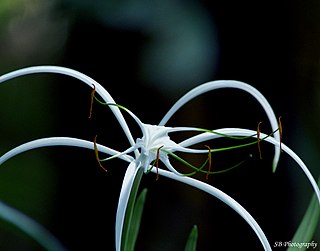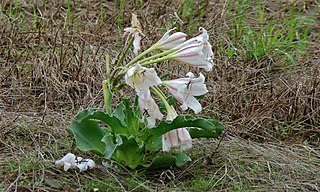
Crinum is a genus of about 180 species of perennial plants that have large showy flowers on leafless stems, and develop from bulbs. They are found in seasonally moist areas, including marshes, swamps, depressions and along the sides of streams and lakes in tropical and subtropical areas worldwide.

Cupressus bakeri, reclassified as Hesperocyparis bakeri, with the common names Baker cypress, Modoc cypress, or Siskiyou cypress, is a rare species of cypress tree endemic to a small area across far northern California and extreme southwestern Oregon, in the western United States.

Crinum latifolium is a herbaceous perennial flowering plant in the amaryllis family (Amaryllidaceae). It arises from an underground bulb. The flowering stems are stout, reaching about 2 m in height. The leaves are long, linear and ligulate. The flowers are white and arranged in an umbel. It grows naturally in Asia, from India and Sri Lanka through much of mainland Southeast Asia to south China. It is also reportedly naturalized in the West Indies and in the Chagos Archipelago.

Crinum pedunculatum also known as the swamp lily, river lily or mangrove lily, is a bulbous perennial found in stream and tidal areas of the Northern Territory, Queensland and New South Wales, Australia as well as New Guinea and some Pacific Islands. It is unclear whether it is native or introduced to Norfolk Island.

Crinum bulbispermum is a herbaceous plant native to South Africa, Lesotho and Swaziland. It is naturalized in the Lesser Antilles, Honduras, Cuba, Florida, Texas, Louisiana, Alabama, South Carolina and North Carolina. Crinum bulbispermum is the floral emblem of the Free State province of South Africa.

Spider lily is the common name for a number of different plant species within the family Amaryllidaceae which belong to the following genera:

Cyrtostachys is a genus of flowering plant in the family Arecaceae. Its species are found in southeast Asia, New Guinea, and in some of the South-Central and Southwest Pacific island habitats of the Oceanian realm.

Crinum thaianum, Common name Thai Onion plant or Water onion, is an emergent plant species endemic to coastal plain of southern Thailand in Ranong and Phang Nga Provinces. Its natural habitat is along the banks of running streams, where its roots and bulb are submerged but the flowering holds the umbel of large, showy flowers above the surface. This natural habits make it a wonderful addition for tropical aquaria, and it is sold in many lands to be used in decorating displays of tropical fish. In nature, however, the species is threatened and diminishing in numbers due to habitat destruction.

Crinum asiaticum, commonly known as poison bulb, giant crinum lily, grand crinum lily, spider lily, is a plant species widely planted in many warmer regions as an ornamental plant. It is a bulb-forming perennial producing an umbel of large, showy flowers that are prized by gardeners. All parts of the plant are, however, poisonous if ingested. Some reports indicate exposure to the sap may cause skin irritation.

The scientific name × Amarcrinum is applied to those hybrid plants obtained from artificial crosses between the genera Amaryllis and Crinum, although as of March 2014, the World Checklist of Selected Plant Families regards the name as "unplaced". They are grown as ornamental plants in gardens.

Brithys crini, the amaryllis borer, crinum borer, lily borer or Kew arches, is a moth of the family Noctuidae. It is a garden pest in parts of its range, as their larvae damage the stems and leaves of lilies, especially lilies of the family Amaryllidaceae.

Crinum americanum is an aquatic angiosperm native to North America from Texas to South Carolina, as well as Mexico, Cuba, Jamaica and the Cayman Islands. Common names for this species include Florida swamp-lily, string lily, and southern swamp crinum. The species grows in small groups in still water habitats.

Aloe bakeri is a species of flowering plant in the family Asphodelaceae, native to Madagascar, where it grows on rocky hills at low elevations. Growing to 10–20 cm (4–8 in) tall by 40 cm (16 in) wide, it is an evergreen perennial forming multiple rosettes of spidery succulent green or reddish-green toothed leaves, heavily mottled with white. The leaves are typically 10 cm long and bear straight or slightly curved white teeth that are 1 mm long and about 1-2 mm apart. In summer it produces red or orange, green-tipped tubular flowers. These flowers are attractive to birds, bees, and wasps, and are typically 2 cm long, borne on racemes 30 cm tall.

Tulipa saxatilis is a Greek and Turkish species of plant in the genus Tulipa of the family Liliaceae.

Amaryllideae are a tribe of subfamily Amaryllidoideae. They are herbaceous monocot perennial flowering plants with a predominantly Southern African distribution, with the exception of the pantropical genus Crinum. They are generally treated as consisting of four subtribes. In addition to Crinum, other genera include Amaryllis, Boophone and Strumaria.

Crinum flaccidum, known variously as the Darling lily, Murray lily or Macquarie lily, is a species of the family Amaryllidae native to inland Australia. The Darling river people — the Paakantyi — called this plant paalampaltharu.

Crinum macowanii is a species of flowering plant in the Amaryllidaceae family. It is a deciduous bulbous plant species native to Africa that has been used in traditional medicine throughout southern Africa.
Crinum rautanenianum is a species of flowering plant in the family Amaryllidaceae, native to Zambia, Botswana and the Caprivi Strip.
















